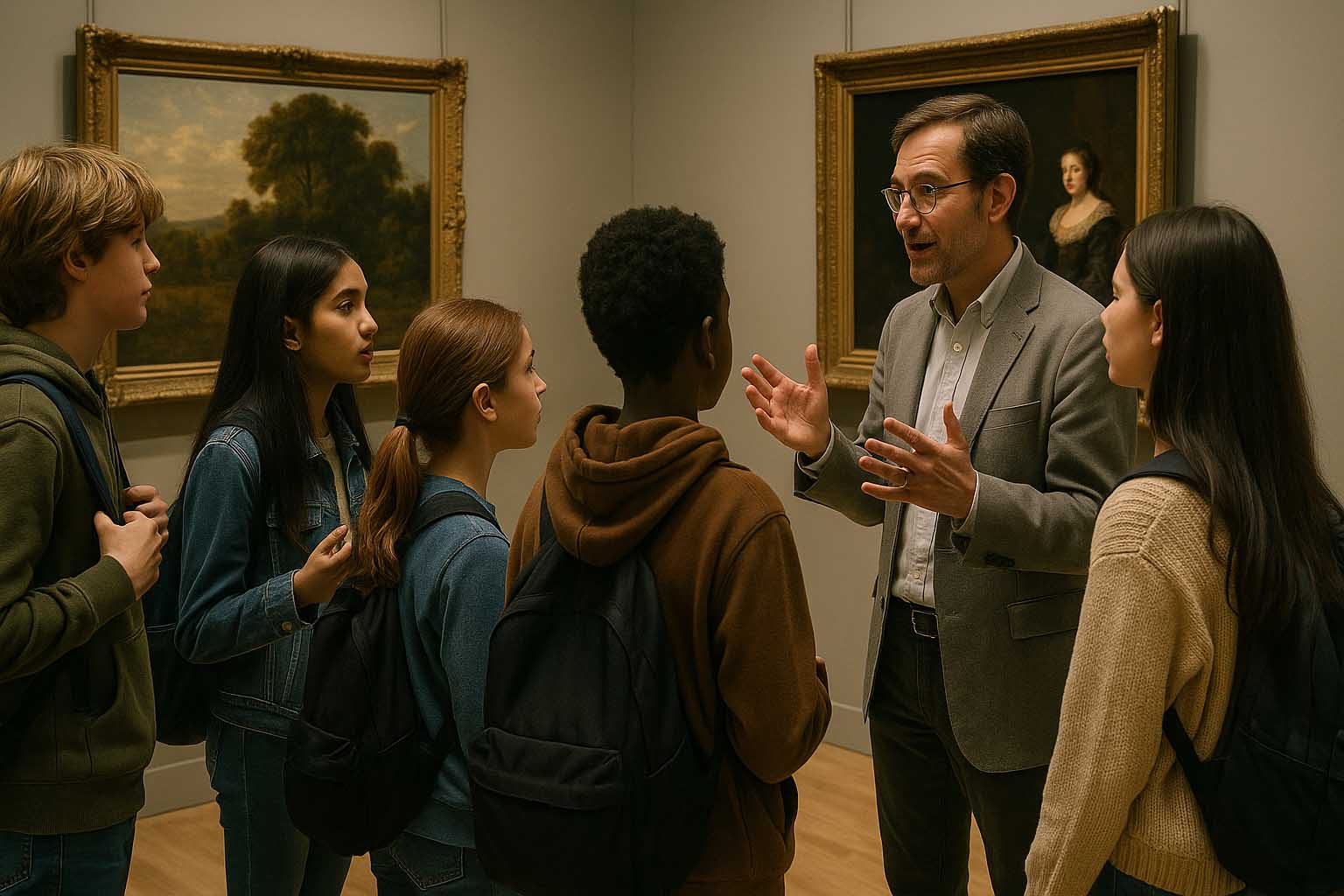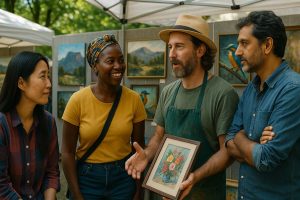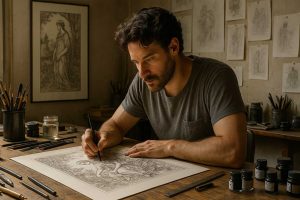
Forging Connections: New Partnerships Between Galleries and Schools
Across the globe, the way we approach learning is transforming. Art and education advocates are embracing a simple yet powerful idea—bringing children closer to art beyond the classroom walls. When galleries and schools work together, they create open spaces for learning where creativity, critical thinking, and cultural engagement can grow.
Connecting Art and Education for Every Child
Not every child gets the chance to visit a museum. When galleries come to schools, they break barriers related to distance, cost, or limited exposure. Art connects subjects like social studies, science, and language in a more vibrant way.
In São Paulo, a public school used a local gallery’s collection to discuss climate change. Students examined artworks made from recycled materials to understand pollution’s impact. The pieces became visual tools as students explored how waste affects the planet.
Teachers use every painting and sculpture as a teaching tool. They get fresh strategies to make lessons more inclusive, while curators also learn about the next generation of audiences and thinkers. This exchange of ideas encourages educators to approach lessons differently, blending art with existing curricula.
How Art Prepares Students for the Global Stage
Many industries now look for creativity and independent thinking—skills nurtured through art. Collaborations between galleries and schools help students analyze symbols and cultural contexts. When a class studies Yayoi Kusama’s work, it’s not just about color and pattern. Conversations also cover topics like identity and mental health.
In Finland, a pilot program combined contemporary art with computer science. Students began by sketching ideas before writing code for interactive installations. They retained concepts like algorithms better when tied to physical creations. This shows that art strengthens not just creativity but also logic, persistence, and teamwork.
Beyond the classroom, these skills extend into real-world settings. Students who engage with visual art tend to show stronger communication, problem-solving, and empathy—qualities valued in nearly every profession.
Examples from Around the World
Tate Exchange (United Kingdom)
The Tate Modern opened a free studio where over 60 universities participate each year. Artists lead sessions, and students develop projects like virtual reality exhibits focused on climate change.
MoMA Teens (United States)
The Museum of Modern Art runs vacation sessions that offer free materials and mentorship. Teens create art that’s featured in the museum’s digital gallery.
Louvre Classe (France)
France’s most famous museum partners with over 500 schools. The program includes teacher training and lends artwork reproductions for use in the classroom when field trips aren’t possible.
National Gallery Singapore Art Buddy (Singapore)
This project offers hybrid tours, where students follow a live-streamed guide on tablets from inside their classroom.
These examples show the flexibility of gallery-school models. Visits can happen on-site, online, or through a mix of both.
Each program is tailored to its local context, proving that one size doesn’t fit all. What they share is a belief in art’s ability to shape thinking, encourage questions, and make education feel alive.
Building Strong and Lasting Collaborations
Successful partnerships start with clear plans and steady coordination. Here are four steps widely used in global initiatives:
1. Define the purpose—whether it’s academic support, community outreach, or hands-on learning.
2. Assign a dedicated contact person at each institution to keep communication flowing.
3. Schedule regular workshops for teachers and curators to align goals and teaching methods.
4. Ensure accessibility—by offering translations or assistive technology where needed.
These practical steps help make the collaboration sustainable and inclusive. Schools and galleries that communicate often tend to avoid misunderstandings, and they’re more likely to achieve their shared goals.
It also helps when expectations are realistic. Not every session has to result in a masterpiece. Sometimes, a simple reflection or dialogue sparked by a sculpture is more valuable than a finished project.
Technology Makes Art More Accessible
Virtual reality and live streaming let students visit galleries without leaving school. A 360-degree camera can take a class through an Italian Renaissance room or African art exhibit—right from a laptop.
Apps that translate exhibit labels into different languages help bridge cultural gaps. In Tokyo, one center used AR badges. When students scanned the badge with a phone, a video of the artist appeared, explaining their techniques. This personal connection boosted student interest and understanding.
In more remote areas, these tools become lifelines. Students who might never have stepped inside a gallery now gain access to artworks from around the world. It shows how technology, when used thoughtfully, can extend cultural education far beyond city limits.
Some schools also use digital art creation tools in class. Whether it’s designing a poster inspired by a gallery visit or experimenting with animation, students learn to use modern media while appreciating traditional art forms.
Benefits for Students, Teachers, and the Community
Students develop imagination and confidence. A study by University College London found that 68% of students who joined gallery-school programs became more engaged in class within six months. That kind of engagement leads to better performance, not just in art, but across all subjects.
For teachers, access to new teaching tools means they can refresh their approach. Rather than repeating the same lessons year after year, educators can link visual art to science experiments, historical timelines, or even literary themes. This makes lessons stick.
Communities benefit, too. When students invite family to gallery open days, foot traffic increases, supporting the local economy. In New Zealand, small businesses near galleries saw a 12% sales boost during school exhibition weeks.
Parents often express pride seeing their children’s work displayed. It builds stronger school-home connections and helps families appreciate the broader value of creative education. These moments of shared pride and learning can leave lasting impressions.
Common Challenges and Creative Solutions
Funding is always a concern—transport, materials, and tickets can add up. Some programs solve this through sponsorships. In Berlin, a startup partnered with a museum to produce student artwork as postcards. Proceeds went to fund future projects.
Time can also be an issue. With packed curriculums, travel days are hard to schedule. That’s why micro-visits are gaining ground. A 30-minute virtual tour fits into a regular class. Early planning makes this easier to integrate into school schedules.
Some teachers worry about their own lack of expertise in art. Programs that include training sessions for educators ease this pressure. When teachers feel supported, they’re more likely to take risks and experiment with cross-subject lessons.
Language can also be a barrier, especially in multicultural communities. Museums that provide translations or multilingual guides make participation smoother. Inclusivity leads to more active and diverse engagement from all students.
Bringing Art Closer to Everyday Learning
Gallery-school partnerships are more than just showcasing artwork. They open doors to a future shaped by curiosity, empathy, and creative thinking. When art becomes part of daily learning, young minds begin to understand the world in deeper, more colorful ways.
These connections help students grow—not just academically, but emotionally and socially. They learn to listen, observe, ask thoughtful questions, and appreciate different perspectives.
With consistent support from curators, educators, families, and the broader community, these efforts build momentum. From classroom to gallery and back again, inspiration flows in both directions—making creativity a natural part of life.
Art isn’t just for the gifted or the privileged. When integrated into education through sincere and structured efforts, it becomes a tool for empowerment. It invites every child to imagine, to question, and to express themselves without limits.
And that’s a future worth building—one painting, one sculpture, one classroom at a time.

